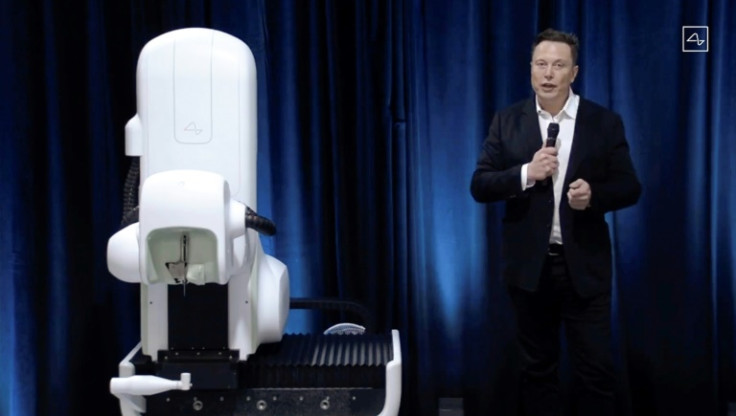First Non-Verbal ALS Patient With Elon Musk's Neuralink Brain Implant Creates Video Featuring AI-Cloned Voice

KEY POINTS
- Smith reiterated that his implant doesn't read his deepest thoughts and only helps him navigate his computer's cursor
- 'I'm so happy to be involved in something big that will help many people,' Smith said
- He said the implant has given him 'freedom' and 'hope' as he can now communicate faster
The first individual with ALS (amyotrophic lateral sclerosis) and the third person to receive a Neuralink brain implant has grabbed the attention of X users overnight after he published a video that shared his journey of hope and finally being able to communicate.
Brad Smith of Arizona took to X on Sunday to publish a video he created using the brain computer interface that makes him control the mouse on his MacBook. "I rely on it [Neuralink implant] for all communication," he said.
Smith Explains How His Implant Works
In the nearly 10-minute video, Smith explained how his implant works, describing it as the tool that gave him "hope" and "freedom" as he lives life with ALS. He is also the first non-verbal patient to receive the implant.
He noted how his voice in the video is his "original" voice that artificial intelligence cloned using old recordings.
Smith thanked his wife, Tiffany, for all her efforts through the years. "She is the key to making Neuralink work," he said.
I am the 3rd person in the world to receive the @Neuralink brain implant.
— Bradford G Smith (Brad) (@ALScyborg) April 27, 2025
1st with ALS. 1st Nonverbal.
I am typing this with my brain. It is my primary communication.
Ask me anything! I will answer at least all verified users!
Thank you @elonmusk! pic.twitter.com/bxYO3SBfA2
Before getting the implant, Smith used an "eye gaze computer" to communicate since losing his ability to speak. While the computer is "a miracle of technology," it has been frustrating for Smith as it worked best in dark rooms.
With Neuralink, Smith can communicate outdoors and it allows him to "ignore light changes."
Smith explained that his implant is only the size of five American quarters in a stack and was implanted in such a way that it avoids his blood vessels "so there is almost no bleeding."
Through Bluetooth technology, the implant connects to a computer, which then begins a bunch of processing to ensure that it filters the "noise" to only focus on what Smith prioritizes.
AI then processes the data collected via the Neuralink implant and delivers the data to a connected MacBook Pro to decode Smith's intended movements. He noted that the implant doesn't read his "deepest thoughts" or what he thinks about. Instead, it only reads "how I want to move and moves the cursor where I want."
Toward the end of the video, Smith said he is working with Neuralink experts to find a way to make him type faster using his implant. He is also learning how to code through the help of Grok, xAI's AI chatbot.
He said his Neuralink experience has been "fantastic" and he is grateful to now be able to communicate faster.
"It has improved my life so much. I'm so happy to be involved in something big that will help many people," he said.
He also thanked Elon Musk, who established Neuralink. The tech titan has also shared Smith's video, which has now logged over 18.5 million views.
X Users Rally in Support of Smith
Less than 24 hours since Smith posted the video that he made with his Neuralink implant, his post has been shared nearly 7,000 times and has gained 4,300 comments from X users who were ecstatic to ask him questions about his journey.
Most of the commenters found inspiration in Smith's story.
Praying Neuralink is one step that can help fully cure ALS.
— Nati Sports (@Nati_Sports) April 28, 2025
Such a terrible disease. One step closer.
Congratulations!
— Herman Högström (@delpirro) April 28, 2025
First, you now have the superpower to verify that you are not thinking about anything when your wife asks ”what are you thinking about…?”
And second, what level of concentration do you need for an action to be executed? Full focus or relaxed?
Many were interested in the potential side effects, while others wondered if Smith feels anything whenever he types with the help of the implant.
Have there been any unanticipated side effects? Do private thoughts ever get exposed?
— Jack Backes (@jackwbackes) April 28, 2025
How long have you had the implant? Have there been any complications like rejection of any of the electrodes? Is this the same Neuralink the other two recipients received or has it advanced in any way since the initial procedures?
— Zak Paine (@RedPill78) April 28, 2025
1) congratulations, holy sh*t.
— dennis hegstad (@dennishegstad) April 28, 2025
2) is there any sensation or feeling that you are typing or not typing, or is it just free flowing?
3) are you able to type as fast as you can think?
can you feel a noticeable difference with your brain post implant? head-aches? nothing?
incredible! wow. it may be difficult to answer, but, how does it 'feel' to typing with your mind ? is it like, you almost envision a muscular action, like typing with hands, or is it more similar to visualizing letters, and then the letters appear -- or something else? thanks!!
— Danielle Fong 🔆 (@DanielleFong) April 27, 2025
Neuralink recently opened its global patient registry for quadriplegia patients. The company has made significant strides in recent years. Late last year, it received approval for trials in Canada and also took the world's attention after its first Neuralink recipient, Noland Arbaugh, played computer chess early last year.
© Copyright IBTimes 2024. All rights reserved.






















